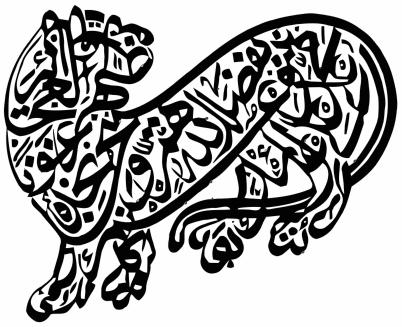Calligrams, or figurative calligraphy, refers to calligraphy in which the letters also form images. In a recent talk at the ISEAS-Yusof Ishak Institute in Singapore, Dr Farouk Yahya, Leverhulme Research Assistant in Islamic Art and Culture at the Ashmolean Museum, University of Oxford, explained that calligrams have been used for devotional and talismanic purposes in various parts of the Islamic world, particularly Iran, Ottoman Turkey, and India.
 | |
| Source: Wikimedia Commons. An example of a lion of Ali, titled "Ismal lion" and contributed by Ishvara7. |
The lion of Ali, better known as the tiger of Ali in Southeast Asia, is a calligram in the form of a large feline. It is usually associated with the Prophet Muḥammad’s (ﷺ) cousin and son-in-law Ali. While the calligram was first known as a lion, tigers are the major predators native to Southeast Asia and the calligram of the large cat eventually became known in this part of the world as a tiger instead, said Dr Farouk. This is especially so in Cirebon in Indonesia, and Kelantan in Malaysia.
The tiger calligram is typically created with the Arabic script of the Quranic verse 61:13 (نَصرٌ مِنَ اللَّهِ وَفَتحٌ قَريبٌ ۗ وَبَشِّرِ المُؤمِنينَ), translated by Sahih International as "Victory from Allah and an imminent conquest; and give good tidings to the believers". Arabic is read from right to left, and Dr Farouk demonstrated how the the verse often began from the eye of the animal.
Asked if the reference to Ali could be a Shia practice in a predominantly Sunni Southeast Asia, Dr Farouk said that Ali reflected respect towards the Prophet's family and acknowledgment that Ali was one of the four caliphs who ruled after Muhammad. "Ali is also found in Ottoman times, and [the Ottomans were] Sunni," he said. "It might connote Sufism." Ali is often considered the father of Sufism.
Tiger calligrams also had a heraldic use. The state flag of Kelantan from 1912 to 1923 uses an animal calligram featuring the "victory from Allah" verse, ending in a mention of the rajah at the tail area. The same calligram is on the Sultan's personal banner, in yellow, versus a blue version for the state. Dr Farouk noted that these particular calligrams were inspired by animal calligrams on the doors of the Sultan's predecessor's palace, and noted that these calligrams are themselves very similar to the lions of Ali in Ottoman times.
A later phrase used in calligrams was "qauluh al-haq wa kalamuh as-sadq" (قل الحق و كلماة الصادق), loosely translated as "I say and write truth", as observed by Annabel Teh Gallop and E Ulrich Katz in The Legacy of the Malay Letter, Dr Farouk said. The phrase used to be common at the beginning of a letter written in Malay.
The calligrams were not just used for personal protection but for protecting assets as well. Dr Farouk shared calligrams used to protect bulls used in bull-fighting in the hope that they would win the fight. The calligrams would be written on leaves which were then consumed by the bulls.
 |
| A calligram in the shape of a paddle-steamer from Cangking, Indonesia, 1866, that is in the Bodleian Libraries collection was shared by Dr Farouk. |
Calligrams in the form of a ship featuring names of the seven sleepers of Ephesus and their dog were used as talismans that bridged travel between the physical and spirit worlds, Dr Farouk said. They were also thought to prevent ships from sinking, and to ensure safe arrival of letters. These were influenced by Persian, Indian and Ottoman models. According to Dr Farouk, the Prophet Muhammad is said to have said that writing the names of the seven sleepers in the form of a ship calligram will ensure that the ship will not sink. In the story the seven youths are said to have been from the port city of Ephesus (present-day Selçuk in Turkey), falling asleep in a cave and waking up centuries later.
Dr Farouk concluded that the power of figural and zoomorphic calligraphy is widespread, with calligrams also found in other scripts and used by non-Muslim populations. Studying them helps to understand how designs are used in a region, how and why motifs travel, and why designs are important in certain areas, he said.
Explore:
The form of the Malay letter from the 16th century (Malay)
*There are variations in the stories but they all agree that there were seven young men who refused to renounce Christianity and were sealed up in a cave. In one variation the cave was unsealed many years later and the youths were discovered to be sleeping, waking as if they had only slept overnight. They woke up at a time when the resurrection after life was being debated, proved they were who they said they were and shortly after went back to sleep permanently.
In the Quran, surah al-Kahf (the cave) mentions a number of men (three to seven) who went to sleep in a cave together with a dog. They awake centuries later and one of them is told to go into town but to be discreet about it (ayah 18:19). He is to be careful because their religion will be disputed, but more context is provided by the Ephesus story, which is considered biblical apocrypha today.